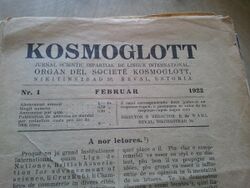Interlingue literature
Interlingue literature broadly encompasses the body of fiction an nonfiction work created or translated into Interlingue, a constructed language created by Edgar de Wahl. Although largely composed of original short stories and translations published in the central magazine of the language, Cosmoglotta, full length novels and poetry anthologies also exist, in particular those by authors such as Vicente Costalago (ie), Jan Amos Kajš (ie), and Jaroslav Podobský (ie).
History
Background
Interlingue, also known as Occidental, is an international auxiliary language created in 1922 by Estonion teacher Edgar de Wahl. It has a largely Western European vocabulary, based largely on the Romance languages, with heavy influence from English. Created in 1922, it was first published in the magazine Kosmoglott (later Cosmoglotta), where it built a following. Due to a lack of published grammars and standardisation, the earliest works in the language used non-standard orthography and grammatical structures.
Publications
The first known publication in Interlingue is the book Transcendent algebra, mathematical ideography, experiment of a philosophical language (Interlingue: Transcendent algebra, ideografie matematical, experiment de un lingue filosofic) by Estonian linguist Jakob Linzbach, a proposal for a pasigraphy.[1] This was translated into Interlingue by de Wahl at Linzbach's request.[2][3] This was published before de Wahl formalised the language in Kosmoglott, while the language was still in its development, as a proto-language named "Auli".[2]
The first work of Interlingue literature as art was by Kaarle Julius Saarinen (fi): a translation of the poem "Hymn" ("Hymne") by Finnish journalist and writer Kaarlo Hammar (fi), appeared in the 1925 edition of Kosmoglott. Several other translations of foreign literature were also published by A. Toman around this time, such as the Wanderer's Nightsong poems by Goethe in the 1926 supplement to Kosmoglott, and a translation of "Nationalism in the West" by Rabindranath Tagore.[4]
In Supplement al Cosmoglotta 7 (1927), a translation of work by Persian poet Saadi Shirazi was presented, alongside work by Hermann Keyserling in the following edition in 1927.
A series of translations were published in the 1930s, including Konstantin Balmont's Where is my home?, Manuel Menendez by Edmondo De Amicis, and A Descent into the Maelström by Edgar Allan Poe. Additionally, several original works were published, such as a poetry anthology, Li Astres del Verne (The Planets of Spring), by Podobský, Krasina, raconta del subterrania del Moravian carst by Kajš, and several works by A. E. Cortinas (ie) and P. Dimitriev. A short story collection, Historiettes in Occidental, was published in 1930 by Ric Berger.[4]
In 1951, with the creation of Interlingua, many occidentalists, including Berger, one of the most important figures of the Interlingue movement, began to support this new IALA language. This led to a large destabilisation of the movement, and while Cosmoglotta continued to be published, it did so with dimishing frequency, ceasing publication in 1985. According to Esperantist author Don Harlow, the editor of Cosmoglotta in this period, Adrian Pilgrim (ie) stated that Interlingue could be described as a "dead language".[citation needed]
However, publications of new literature in Interlingue continued throughout the 1950s and the early 1960s, with translations including "A Mother Speaks" by Czech Jiří Marek in 1954, Multatuli's "The alocution to the bosses of Lebak", and "Wedding Shirt (cz)" by Karel Jaromír Erben, translated by Josef Křesina.
Other translated books included Arvid Brenner's Un Adío (A Farewell) and Bo Bergman's A Desertor by Eric Ahlström in 1958. In 1964, Francis R. Pope (ie) published Poemas (Poems), an anthology consisting of poems translated from German, French, and English.[4]
The revival of Interlingue began in 1999 with the creation of a Yahoo! group for the language, after a decade of decay in the 1980s and 1990s. In the early 2000s, Interlingue Wikipedia was created, which had over 5000 articles in 2020.[4]
Many original Interlingue texts as well as translations have been published since 2000, with the first being Stendhal's The Charterhouse of Parma (Li Cartusie de Parma), translated by Robert Winter in 2011. In 2012, Thomas Schmidt published Li Munde de Sandra in an online magazine, Posta Mundi, which contains material published in constructed languages. This was followed with a translation of The Little Prince in 2014.
Notable authors
- Jan Amos Kajš
- Jaroslav Podobský
- Engelbert Pigal
- Abram Kofman
- A.E. Cortinas
- Ilmari Federn
- Thomas Schmidt
- Dorlota Burdon
- Vicente Costalago
See also
- Esperanto literature
References
Citations
- ↑ Moret, Sébastien (2019). "Jakob Linzbach on his life and work". Sign Systems Studies 47 (1/2): 305. ISSN 1736-7409. https://www.academia.edu/78129503/Jakob_Linzbach_on_his_life_and_work.
- ↑ 2.0 2.1 Barandovská-Frank, Vĕra. "Latinidaj planlingvoj" (in eo). https://interl.home.amu.edu.pl/interlingvistiko/Barandovska_Latinidaj_planlingvoj.pdf.
- ↑ Linzbach, Jakob (1921). "De autor" (in ie). Transcendent algebra, ideografie matematical, experiment de un lingue filosofic. Tallinn. https://tck.mn/transalg/. "mi ha petit li conosset cosmoglottist sr. E. de Wahl traducter li textu de ti ci brochur in composit de il lingue universal auxiliari "Occidental" [I have asked the famed interlinguist Mr. E. de Wahl to translate the text of this brochure into his international auxiliary language "Occidental"]"
- ↑ 4.0 4.1 4.2 4.3 Costalago 2022, pp. 4-5.
Sources
- Costalago, Vicente (July 2022). "Literatura in Interlingue". Cosmoglotta (329): 2–15. https://archive.org/details/cg-329-2022/page/4/mode/2up.
 |



